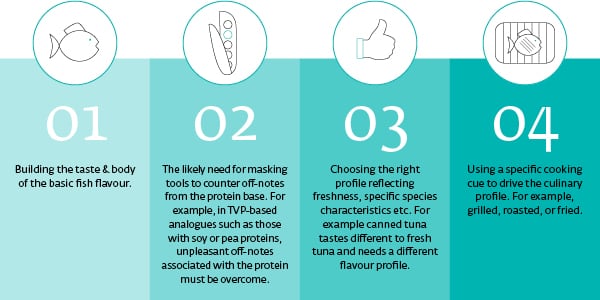Plant-based fish and seafood products look set to be the next big thing in alternative protein but they present unique challenges for manufacturers
Plant-based innovation is one of the biggest growth areas within the food industry and following the dramatic rise of alternative meat products, fish and seafood substitutes are now poised for dynamic growth. Investment in alternative fish and seafood start-ups has been brisk, and new companies and products are entering the market all the time.
For manufacturers preparing to take the plunge, plant-based fish and seafood presents great opportunities and, of course, their own complex challenges. The look, feel, nutritional content and most importantly taste must all be right and these must be addressed holistically to get the desired end result.
Taste still drives consumer preference
While ethical, health or environmental concerns are important to the consumer, ultimately the deciding factor is still the tastiness of the product. If it doesn’t taste good the consumer is unlikely to buy the product again.
There are four key areas for consideration when developing the flavour.

Once the basic fish flavour has been developed, one of the most challenging areas for plant-based products is the masking of off-notes from the protein base, especially if a mix of proteins are used. Givaudan has developed a range of masking solutions that can be tailored to the specific taste challenges for each protein or protein combination, using a wealth of knowledge codified into our Smart-Masking tool. This offers our flavourists fast access to high-performance solutions that combat off-notes across multiple plant-based proteins, to deliver better end results.
Flavour profiles are added for authenticity, together with specific cooking cues such as grilled, smoked, poached or fried for a really appetising taste.
Alternative fish and seafood products also lend themselves well to pre-prepared dishes. Consumers are excited by new taste experiences and there is a big opportunity to develop dishes inspired by flavours and spice blends from the many cuisines around the world where fish and vegetable dishes take centre stage.
Particularly popular at the moment are dishes using inspiration from Asian flavour palettes such as teriyaki, red and green curry and soy sauce. Working closely with our customers we can design delicious culinary concepts that appeal to consumers and differentiate your products.
Creating an authentic eating experience
The right eating experience is a vital part of creating a successful product. Choosing the right protein base is the first stage of this process and this depends on a number of factors such as nutritional content, functionality, texture, taste, sourcing and cost.
Soy, with its high protein content, is the first choice for manufacturers of fish and seafood substitutes. Its flexibility and low cost make it a very attractive source, but it is also an allergen, which means it is not suitable for all consumers. Pea is a popular allergen-free alternative, especially for higher quality products.
Many manufacturers use soy or pea as their primary base with wheat gluten sources to balance the mix. Other popular plant-based proteins which can be used alone or in combination are oats, chickpea, lentils, fava and navy beans, sunflower and flaxseed.
For shellfish substitutes, manufacturers use seaweed, algae or starches such as konjac powder as a base. These closely mimic the texture of real shrimp and can be applied to lobster, crab, prawn and calamari alternatives. The biggest drawback of these bases is their low protein levels and therefore additional protein must be added to boost their nutritional content.
To create a ‘meaty’ bite and appearance, the protein source is put through a texturizing process – essentially a kneading process similar to that of bread making. There are two versions of this process, wet TVP and dry TVP with the former more successful in creating the right texture for fish products. For the more bouncy, non-fibrous texture of shellfish, starch gelation is more commonly used.
Getting the mouthfeel right is one of the most difficult parts of this process. It can be achieved through a mix of agents – gels, protein isolates, and starches – which are incorporated into the recipe, along with the protein base, during production. The desired mouthfeel will determine which ingredients are needed and our experts work closely with customers using their extensive hands-on application knowledge to create an enjoyable eating experience.
Easy on the eye
Visual appeal is hugely important in food, and colour solutions for fish substitutes vary in difficulty depending upon the sub-category. For whitefish, it is necessary to whiten the plant-based protein base, which is beige to yellow depending on the formulation. Salmon and crustaceans require orange to pink/red colours with good stability across processes. For tuna, manufacturers are looking to replicate the colour change that happens during cooking when fresh tuna turns from a deep red colour to brown.
This colour change can be a real challenge due to the complexity of food matrices in these products. Naturex’s VegeBrite Reds and Brown colouring foodstuffs are customised solutions specifically formulated to address this. Using a combination of different natural extracts and concentrates it is possible to create the much-desired cooking transition effect.
Finally, as the environment and health are both key consumer drivers, natural and vegetarian colours are a must, and vegan colours are highly desirable.
Riding the next wave of alternative protein products
Although fish and seafood substitutes present some unique product development challenges, they also represent the biggest opportunity for food companies in this space.
Givaudan’s experts can help you ‘ride the wave’ using our unrivalled experience, capabilities and tools to deliver delicious, appealing alternative fish and seafood products that consumers love.
Let’s recreate together the enjoyment of real fish and seafood!








